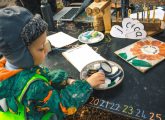Barbara Isaacs looks at the varied ways in which children can be introduced to life on Earth…
Montessori wanted young children to have close contact with nature and also learn about the physical features of the world and its people. Whilst history is introduced with the help of calendars and timelines, explorations of magnets, colours and the properties of water are part of everyday life in a Montessori nursery classroom. This area of the curriculum is referred to by Montessorians as ‘cultural studies’, whereas the Early Years Foundation Stage aptly names it Understanding the world. And this was really Montessori’s aim – to give young children an opportunity to learn about all elements of life on Earth.
We usually begin by exploring the immediate environment – the focus is on creatures found in the nursery garden or on nature walks. Many Montessori settings embrace forest school training as a fitting addition to this area of learning. Growing flowers and vegetables and caring for nursery pets has been part of Montessori practice since the beginning of the 20th century. In addition, children will find on the nursery shelves a range of matching and pairing activities, wherever possible using real fruits and vegetables, and also models of animals rather than pictures, enabling them to find members of the individual families and group mother and baby animals, etc. Children also explore flowers as they arrange them in the classroom or look after them in the garden, and match leaves with pictures of the plants to which they belong.
When looking at geography, Montessori children usually begin by exploring the solar system and looking at the map of the world and its continents, and the people and animals who live there. Physical features such as rivers and mountains are explored, as are celebrations from different cultures. The diversity of human life is usually reflected in collections of objects representing a continent or country. As the nursery’s collections grow, they’re housed in baskets or chests of drawers. Typically, they include children’s traditional clothes and accessories as well as money, books, types of transport, music, models of animals found in that continent, and pictures of families in typical houses, eating typical food and celebrating festivals. When children start exploring these boxes, often as part of a planned project which can span across a whole term, they’ll also cook food from that continent or country and have visitors to tell them about their life.
With growing globalisation it’s easy to find artefacts for these boxes, but it’s increasingly difficult to identify the unique features of these continents without being either tokenistic or stereotypical. None-the-less, children really enjoy the continental collections, which often serve as props for dressing up and role play.
One of the most popular activities on the shelf in this area of learning is the mapping game: essentially a ‘small world’ activity. It gives children the opportunity to put together a model town, village or city using two identical base-boards, which include roads, a rail line, and a hill and a lake or pond accompanied by two sets of buildings. As two children, or a child with an adult, engage with the materials, they have the opportunity to explore and describe models of the buildings, their structure and features. The participants discuss where they would like to place the buildings on their base boards. They take turns in their decision-making; therefore, one always copies the other, using his/her observational skills and attention to details as the identical placement is made. In addition to developing children’s spatial awareness, the game also increases prepositional language and conversational skills, and supports cooperation. Why not try it out?
Barbara Isaacs is the academic director of Montessori Centre International.

Science talk
Editors picks

Outdoor maths activities – Marvellous muddy maths ideas
Editors picks
